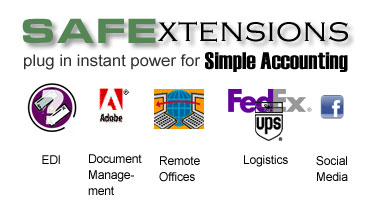How Usage And Inventory Levels Are Calculated
This topic discusses how Simple Accounting calculates how much of a product has been used, and how it can predict future ordering patterns.
Important Fields In Each Product
The fields in each Product which track inventory levels are:
ON HAND The sum total of the available quantities of a product at all Sites (Ship Tos) linked to the Distributor (you) or the vendors who manufacture or store the product. In other words, how much of the item is available for release.
ON SITE The sum total of the available quantities of a product at all Sites (Ship Tos) linked to a customer. In other words, how much of the item is currently considered in use at the customers location(s).
 The On SITE QUANTITY refers only to the Product Master. When viewing inventory levels at each Site (Ship To) there is only an ON HAND QUANTITY field that indicates the amount at that particular Site.
The On SITE QUANTITY refers only to the Product Master. When viewing inventory levels at each Site (Ship To) there is only an ON HAND QUANTITY field that indicates the amount at that particular Site.
The fields that determine when these fields are increased or decreased are:
OWNED BY Products may be Customer Owned, Distributor Owned, Vendor Owned, or N/A. The product must be either
Customer or Distributor Owned in order for Simple Accounting to track inventory levels (the ON HAND or ON SITE quantity). However, this field can be overridden on a particular purchase order or sales order. In other words, a product can sometimes be Distributor owned, and sometimes not.
The ON SITE quantity is affected only
 Although you can change the OWNED BY per transaction, you cannot change the method by which you calculate usage per transaction. That is, an item cannot sometimes be calculated based on counts and then other times by releases.
Although you can change the OWNED BY per transaction, you cannot change the method by which you calculate usage per transaction. That is, an item cannot sometimes be calculated based on counts and then other times by releases.
USAGE If the product is Customer Owned or Distributor Owned, you need to tell Simple
CALCULATED BY Accounting how to determine usage for that product. More specifically, you need to tell Simple Accounting when an item is considered used. There are three choices:
Counts Usage is calculated by taking counts. If the product is not Customer or Distributor owned, you may not calculate usage by taking counts.
Between Releases Product is considered used after the next release. In other words, if you delivered 5,000 forms to a site on May 1, then delivered 10,000 on September 1, Simple Accounting assumes that 5,000 where used in the period between May 1 and September 1.
When Released Usage is calculated by sales or F/M Releases of the item. This assumes that the item is completely used on the ship date. In the previous example, Simple Accounting would assume that 5,000 had been used on May 1.
How Inventory Levels are Updated
And of course, the type of transaction (sales, receiving a purchase order, count, release) is what actually makes inventory go up or down for Distributor or Customer Owned products. When you invoice a Distributor Owned or Customer Owned product, the ON HAND quantity is reduced by the SHIP QUANTITY of the sales line item.
Reminder: ON HAND and ON SITE quantities are only affected for Customer Owned or Distributor Owned Products.
When you print a Vendor Purchase Order then enter a received quantity for the item, the ON HAND QUANTITY is increased by the received quantity. Also, the ON HAND QUANTITY for that particular Site is increased.
The ON SITE quantity of Customer or Distributor Owned items only changes if the product is set to calculate usage by TAKING COUNTS. In that case, the ON SITE QUANTITY is increased by the amount shipped on a sales invoice (in effect, you are transferring the quantity from ON HAND to ON SITE). You would then need to take a count in order to show usage at the end-user site and reduce the ON SITE QUANTITY over time.
There is one important exception regarding Customer Owned products and Sales Orders: If you ship a product to a vendor warehouse or to your own warehouse, then the ON HAND QUANTITY is increased by that amount and the ON SITE is unaffected.
This is a real time-saver as it allows you to order product for a customer, bill them, indicate a partial shipment to the customer while reserving the balance in off-line storage all from one Sales Order!
Summary
The following tables lists each type of transaction and its affect on the ON HAND quantity and ON SITE quantity for each product master.
|
When You Order Product From A Sales Order With A PO Or The Purchase Order Browse |
|||||||
|
OWNED |
SHIP |
USAGE |
MASTER QUANTITIES |
SITE QUANTITIES |
|||
|
BY |
FROM |
TO |
CALCULATED BY |
ON HAND |
ON SITE |
FROM |
TO |
|
Distributor |
V,D |
C |
Counts |
– |
+ |
|
|
|
Customer |
V,D |
C |
Counts |
– |
+ |
|
|
|
Distributor |
V |
D |
Counts |
N/A |
N/A |
|
|
|
Customer |
V |
D |
Counts |
+ |
N/A |
|
|
|
Distributor |
V,D |
C |
Releases |
– |
N/A |
|
|
|
Customer |
V,D |
C |
Releases |
N/A |
N/A |
|
|
|
When You Ship/Receive Product From A Sales Order With A PO Or The Purchase Order Browse |
|||||||
|
OWNED |
SHIP |
USAGE |
MASTER QUANTITIES |
SITE QUANTITIES |
|||
|
BY |
FROM |
TO |
CALCULATED BY |
ON HAND |
ON SITE |
FROM |
TO |
|
Distributor |
V,D |
C |
Counts |
– |
+ |
|
|
|
Customer |
V,D |
C |
Counts |
– |
+ |
|
|
|
Distributor |
V |
D |
Counts |
N/A |
N/A |
|
|
|
Customer |
V |
D |
Counts |
+ |
N/A |
|
|
|
Distributor |
V,D |
C |
Releases |
– |
N/A |
|
|
|
Customer |
V,D |
C |
Releases |
N/A |
N/A |
|
|
|
When You Create A Release Either From A Sales Order Or F/M Browse |
|||||||
|
OWNED |
SHIPPING |
USAGE |
QUANTITIES |
SITE QUANTITIES |
|||
|
BY |
FROM |
TO |
CALCULATED BY |
ON HAND |
ON SITE |
FROM |
TO |
|
Distributor |
V,D |
C |
Counts |
– |
+ |
|
|
|
Customer |
V,D |
C |
Counts |
– |
+ |
|
|
|
Distributor |
V |
D |
Counts |
N/A |
N/A |
|
|
|
Customer |
V |
D |
Counts |
+ |
N/A |
|
|
|
Distributor |
V,D |
C |
Releases |
– |
N/A |
|
|
|
Customer |
V,D |
C |
Releases |
N/A |
N/A |
|
|
|
When You Taked A Forms Management Count |
|||
|
OWNED |
TYPE OF SITE |
QUANTITIES |
|
|
BY |
COUNTED AT |
ON HAND |
ON SITE |
|
Distributor |
V,D |
-/+ |
N/A |
|
Customer |
V,D |
-/+ |
N/A |
|
Distributor |
C |
N/A |
-/+ |
|
Customer |
C |
N/A |
-/+ |
|
When You Make Forms Management Adjustments/Write-Offs |
|||
|
OWNED |
TYPE OF |
QUANTITIES |
|
|
BY |
SITE |
ON HAND |
ON SITE |
|
Distributor |
V,D |
-/+ |
N/A |
|
Customer |
V,D |
-/+ |
N/A |
|
Distributor |
C |
N/A |
-/+ |
|
Customer |
C |
N/A |
-/+ |
+ Quantity is increased. V Vendor Site
– Quantity is decreased. D Distributor Site
N/A Does Not Apply C Customerr Site



